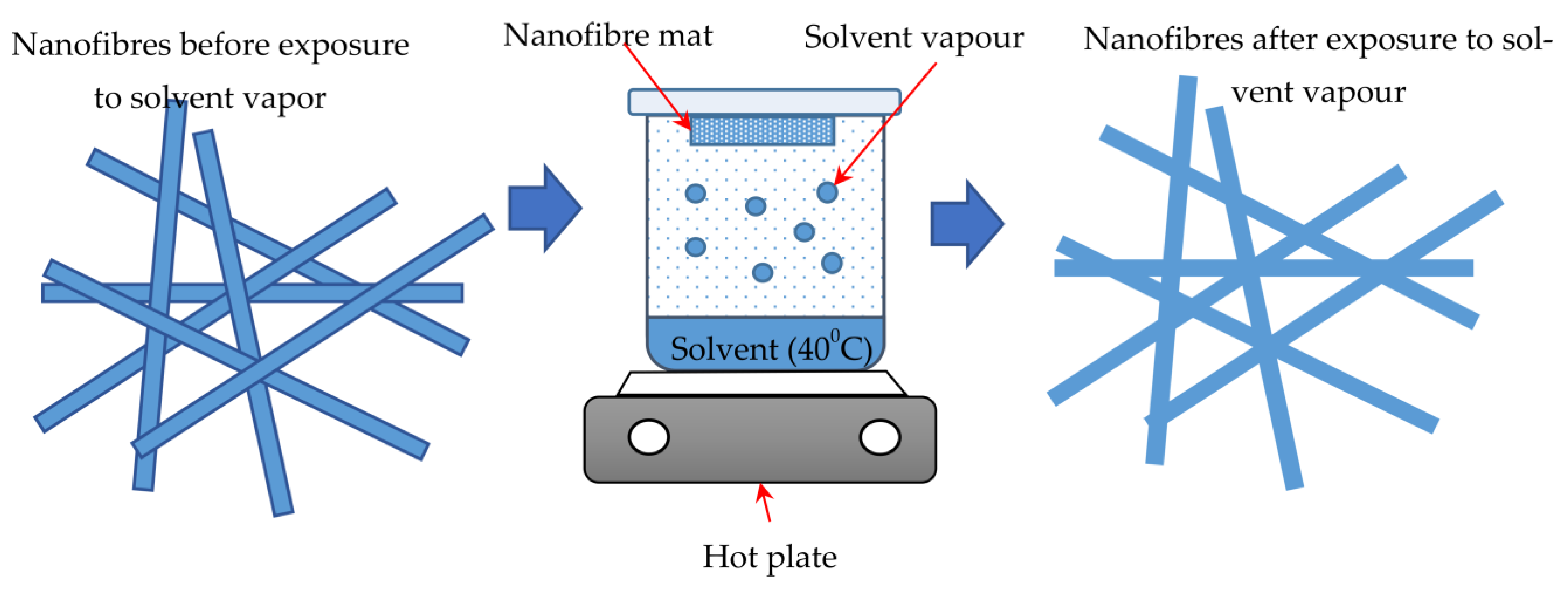Enhancing Mechanical Properties and Flux of Nanofibre Membranes for Water Filtration
Abstract
1. Introduction
2. Nanofibre as Water Filtration Membrane
3. Advantages and Challenges of Using Nanofibre Membranes in Water Treatment
3.1. Advantages
3.2. Challenges
4. Mechanism of Enhancing the Mechanical Properties of Nanofibre Membrane
5. Mechanical Properties and Water Flux of Nanofibre Membrane after Solvent Vapour Treatment
5.1. The Mechanical Properties of the Nanofibre Membrane after Solvent Vapour Treatment
5.2. The Effects of Solvent Vapour Treatment on Water Flux
6. Mechanical Properties and Water Flux of Nanofibre Membrane after Heat-Treatment
6.1. The Mechanical Properties of Nanofibre Membranes after Heat-Treatment
6.2. The Effects of Heat-Treatment on Water Flux
7. Mechanical Properties and Water Flux of Nanofibre Membrane after Chemical Crosslinking
7.1. The Mechanical Properties of Nanofibre Membranes after Chemical Crosslinking
7.2. The Effects of Chemical Crosslinking on Water Flux
8. Experimental and Computational Analysis of the Modifications of Nanofibre Membrane Strength
9. Summary and Future Perspective
Author Contributions
Funding
Data Availability Statement
Acknowledgments
Conflicts of Interest
References
- Lim, C.T. Nanofiber technology: Current status and emerging developments. J. Prog. Polym. Sci. 2017, 70, 1–17. [Google Scholar]
- Toriello, M.; Afsari, M.; Shon, H.; Tijing, L. Progress on the fabrication and application of Electrospun Nanofiber composites. J. Membr. 2020, 10, 204. [Google Scholar] [CrossRef]
- Jiang, S.; Chen, Y.; Duan, G.; Mei, C.; Greiner, A.; Agarwal, S. Electrospun nanofiber reinforced composites: A review. J. Polym. Chem. 2018, 9, 2685–2720. [Google Scholar] [CrossRef]
- Ma, H.; Hsiao, B.S. Current advances on Nanofiber membranes for water purification applications. In Filtering Media by Electrospinning; Springer: Cham, Switzerland, 2018; pp. 25–46. [Google Scholar]
- Xue, J.; Wu, T.; Dai, Y.; Xia, Y. Electrospinning and Electrospun Nanofibers: Methods, Materials, and Applications. J. Chem. Rev. 2019, 119, 5298–5415. [Google Scholar] [CrossRef] [PubMed]
- Cui, J.; Li, F.; Wang, Y.; Zhang, Q.; Ma, W.; Huang, C. Electrospun nanofiber membranes for wastewater treatment applications. J. Sep. Purif. Technol. 2020, 250, 117116. [Google Scholar] [CrossRef]
- Eyvaz, M.; Arslan, S.; Gürbulak, E.; Yüksel, E. Textile Materials in Liquid Filtration Practices: Current Status and Perspectives in Water and Wastewater Treatment. In Textiles for Advanced Applications; IntechOpen: London, UK, 2017. [Google Scholar]
- Fahimirad, S.; Fahimirad, Z.; Sillanpää, M. Efficient removal of water bacteria and viruses using electrospun nano-fibers. J. Sci. Total Environ. 2021, 751, 141673. [Google Scholar] [CrossRef]
- Roche, R.; Yalcinkaya, F. Incorporation of PVDF Nanofibre Multilayers into Functional Structure for Filtration Applications. Nanomaterials 2018, 8, 771. [Google Scholar] [CrossRef]
- Liu, P.; Zhu, C.; Mathew, A.P. Mechanically robust high flux graphene oxide—Nanocellulose membranes for dye removal from water. J. Hazard. Mater. 2019, 371, 484–493. [Google Scholar] [CrossRef]
- Mataram, A.; Ismail, A.F.; Yuliwati, E.; Matsuura, T.; Zamheri, A.; Rizal, S. Water Treatment Perfomance: Application of Electrospun Nanofibers. J. Teknol. 2015, 77, 263–267. [Google Scholar] [CrossRef][Green Version]
- Li, X.; Liu, T.; Zhang, Y.; Cai, J.; He, M.; Li, M.; Chen, Z.; Zhang, L. Growth of BiOBr/ZIF-67 Nanocomposites on Carbon Fiber Cloth as Filter-Membrane-Shaped Photocatalyst for Degrading Pollutants in Flowing Wastewater. Adv. Fiber Mater. 2020, 4, 1620–1631. [Google Scholar] [CrossRef]
- Li, S.; Cai, M.; Liu, Y.; Wang, C.; Lv, K.; Chen, X. S-Scheme photocatalyst TaON/Bi2WO6 nanofibers with oxygen vacancies for efficient abatement of antibiotics and Cr(VI): Intermediate eco-toxicity analysis and mechanistic insights. Chin. J. Catal. 2022, 43, 2652–2664. [Google Scholar] [CrossRef]
- Koley, G. Editorial for the Special Issue on MEMS/NEMS Sensors: Fabrication and Application. J. Micromachines 2019, 10, 242. [Google Scholar] [CrossRef]
- Islam, M.S.; Ang, B.C.; Andriyana, A.; Afifi, A.M. A review on fabrication of nanofibers via electrospinning and their applications. SN Appl. Sci. 2019, 1, 1248. [Google Scholar] [CrossRef]
- Hu, J.; Zhang, K.-Q. Electrospun Nanofibers for Optical Applications. In Electrospinning: Nanofabrication and Applications; Elsevier: Amsterdam, The Netherlands, 2019. [Google Scholar]
- Haider, A.; Haider, S.; Kang, I.-K. A comprehensive review summarizing the effect of electrospinning parameters and potential applications of nanofibers in biomedical and biotechnology. Arab. J. Chem. 2018, 11, 1165–1188. [Google Scholar] [CrossRef]
- Ibrahim, H.M.; Klingner, A. A review on electrospun polymeric nanofibers: Production parameters and potential applications. Polym. Test. 2020, 90, 106647. [Google Scholar] [CrossRef]
- Pillay, V.; Dott, C.; Choonara, Y.E.; Tyagi, C.; Tomar, L.; Kumar, P.; Du Toit, L.C.; Ndesendo, V.M. A review of the effect of processing variables on the fabrication of Electrospun nanofibers for drug delivery applications. J. Nanomater. 2013, 2013, 789289. [Google Scholar] [CrossRef]
- Amna, R.; Ali, K.; Malik, M.I.; Shamsah, S.I. A Brief Review of Electrospinning of Polymer Nanofibers: History and Main Applications. J. New Mater. Electrochem. Syst. 2020, 23, 151–163. [Google Scholar] [CrossRef]
- Huang, L.; Arena, J.T.; Manickam, S.S.; Jiang, X.; Willis, B.G.; McCutcheon, J.R. Improved mechanical properties and hydrophilicity of electrospun nanofiber membranes for filtration applications by dopamine modification. J. Membr. Sci. 2014, 460, 241–249. [Google Scholar] [CrossRef]
- Abd Halim, N.S.; Wirzal, M.D.; Bilad, M.R.; Md Nordin, N.A.; Adi Putra, Z.; Sambudi, N.S.; Mohd Yusoff, A.R. Improving performance of Electrospun nylon 6,6 Nanofiber membrane for produced water filtration via solvent vapor treatment. J. Polym. 2019, 11, 2117. [Google Scholar] [CrossRef]
- Guibo, Y.; Qing, Z.; Yahong, Z.; Yin, Y.; Yumin, Y. The electrospun polyamide 6 nanofiber membranes used as high efficiency filter materials: Filtration potential, thermal treatment, and their continuous production. J. Appl. Polym. Sci. 2012, 128, 1061–1069. [Google Scholar] [CrossRef]
- Pereao, O.K.; Bode-Aluko, C.; Ndayambaje, G.; Fatoba, O.; Petrik, L.F. Electrospinning: Polymer Nanofibre Adsorbent Applications for Metal Ion Removal. J. Polym. Environ. 2016, 25, 1175–1189. [Google Scholar] [CrossRef]
- Rianjanu, A.; Kusumaatmaja, A.; Suyono, E.A.; Triyana, K. Solvent vapor treatment improves mechanical strength of electrospun polyvinyl alcohol nanofibers. J. Heliyon 2018, 4, e00592. [Google Scholar] [CrossRef] [PubMed]
- Munaweera, K.I.; Kottegoda, N. A comprehensive review on electrospun nanohybrid membranes for wastewater treatment. Beilstein J. Nanotechnol. 2022, 13, 137–159. [Google Scholar]
- Okutan, N.; Terzi, P.; Altay, F. Affecting parameters on electrospinning process and characterization of electrospun gelatin nanofibers. Food Hydrocoll. 2022, 39, 2014. [Google Scholar] [CrossRef]
- Fauzi, A.; Hapidin, D.A.; Munir, M.M.; Iskandar, F.; Khairurrijal, K. A superhydrophilic bilayer structure of a nylon 6 nanofiber/cellulose membrane and its characterization as potential water filtration media. RSC Adv. 2020, 10, 17205–17216. [Google Scholar] [CrossRef]
- Huang, L.; Manickam, S.S.; McCutcheon, J.R. Increasing strength of electrospun nanofiber membranes for water filtration using solvent vapor. J. Membr. Sci. 2013, 436, 213–220. [Google Scholar] [CrossRef]
- Liu, C.; Li, X.; Liu, T.; Liu, Z.; Li, N.; Zhang, Y.; Xiao, C.; Feng, X. Microporous CA/PVDF membranes based on electrospun nanofibers with controlled crosslinking induced by solvent vapor. J. Membr. Sci. 2016, 512, 1–12. [Google Scholar] [CrossRef]
- Li, H.; Zhu, C.; Xue, J.; Ke, Q.; Xia, Y. Enhancing the Mechanical Properties of Electrospun Nanofiber Mats through Controllable Welding at the Cross Points. Macromol. Rapid Commun. 2017, 38, 1600723. [Google Scholar] [CrossRef]
- Wu, H.; Shi, J.; Ning, X.; Long, Y.-Z.; Zheng, J. The High Flux of Superhydrophilic-Superhydrophobic Janus Membrane of cPVA-PVDF/PMMA/GO by Layer-by-Layer Electrospinning for High Efficiency Oil-Water Separation. J. Polym. 2022, 14, 621. [Google Scholar] [CrossRef]
- El-Aswar, E.I.; Ramadan, H.; Elkik, H.; Taha, A.G. A comprehensive review on preparation, functionalization and recent applications of nanofiber membranes in wastewater treatment. J. Environ. Manag. 2022, 301, 113908. [Google Scholar] [CrossRef]
- Attari, N.; Hausler, R. Mechanical Characterization of Nanocelluloses/Cellulose Acetate Composite Nanofibrous Membranes. Res. Sq. 2022. [Google Scholar] [CrossRef]
- Namsaeng, J.; Punyodom, W.; Worajittiphon, P. Synergistic effect of welding electrospun fibers and MWCNT reinforcement on strength enhancement of PAN–PVC non-woven mats for water filtration. J. Chem. Eng. Sci. 2019, 193, 230–242. [Google Scholar] [CrossRef]
- Khatri, M.; Francis, L.; Hilal, N. Modified Electrospun Membranes Using Different Nanomaterials for Membrane Distillation. Membranes 2023, 13, 338. [Google Scholar] [CrossRef]
- Ehrmann, A. Non-Toxic Crosslinking of Electrospun Gelatin Nanofibers for Tissue Engineering and Biomedicine—A Review. Polymers 2021, 13, 1973. [Google Scholar] [CrossRef] [PubMed]
- Alias, A.H.; Norizan, M.N.; Sabaruddin, F.A.; Asyraf, M.R.; Norrrahim, M.N.; Ilyas, A.R.; Kuzmin, A.M.; Rayung, M.; Shazleen, S.S.; Nazrin, A.; et al. Hybridization of MMT/Lignocellulosic Fiber Reinforced Polymer Nanocomposites for Structural Applications: A Review. Coatings 2021, 11, 1355. [Google Scholar] [CrossRef]
- Covelo, A.; Rodil, S.; López-Villegas, E.O.; Álvarez, C.A.; Hernandez, M. Evaluation and correlation of electrochemical and mechanical properties of PVA/SA nanofibres. Surf. Interface Anal. 2020, 52, 1128–1133. [Google Scholar] [CrossRef]
- Jeong, L.; Lee, K.Y.; Liu, J.W.; Park, W.H. Time-resolved structural investigation of regenerated silk fibroin nanofibers treated with solvent vapor. Int. J. Biol. Macromol. 2006, 38, 140–144. [Google Scholar] [CrossRef]
- Cai, J.; Zhang, Q.; Lei, M.; He, J.; Liu, G. The use of solvent-soaking treatment to enhance the anisotropic mechanical properties of electrospun nanofiber membranes for water filtration. RSC Adv. 2016, 6, 66807–66813. [Google Scholar] [CrossRef]
- Wang, Y.; Górecki, R.P.; Stamate, E.; Norrman, K.; Aili, D.; Zuo, M.; Guo, W.; Hélix-Nielsen, C.; Zhang, W. Preparation of super-hydrophilic polyphenylsulfone nanofiber membranes for water treatment. RSC Adv. 2019, 9, 278–286. [Google Scholar] [CrossRef]
- Kiani, S.; Mousavi, S.; Shahtahmassebi, N.; Saljoughi, E. Preparation and characterization of polyphenylsulfone nanofibrous membranes for the potential use in liquid filtration. J. Desalination Water Treat. 2015, 57, 16250–16259. [Google Scholar] [CrossRef]
- Ozbey-Unal, B.; Gezmis-Yavuz, E.; Eryildiz, B.; Koseoglu-Imer, D.Y.; Keskinler, B.; Koyuncu, I. Boron removal from geothermal water by nanofiber-based membrane distillation membranes with significantly improved surface hydrophobicity. J. Environ. Chem. Eng. 2020, 8, 104113. [Google Scholar] [CrossRef]
- Li, L.; Hashaikeh, R.; Arafat, H.A. Development of eco-efficient micro-porous membranes via electrospinning and annealing of poly (lactic acid). J. Membr. Sci. 2013, 436, 57–67. [Google Scholar] [CrossRef]
- Guclu, S.; Pasaoglu, M.E.; Koyuncu, I. Membrane manufacturing via simultaneous electrospinning of PAN and PSU solutions. Desalination Water Treat. 2015, 57, 8152–8160. [Google Scholar] [CrossRef]
- Homaeigohar, S.; Koll, J.; Lilleodden, E.T.; Elbahri, M. The solvent induced interfiber adhesion and its influence on the mechanical and filtration properties of polyethersulfone electrospun nanofibrous microfiltration membranes. Sep. Purif. Technol. 2012, 98, 456–463. [Google Scholar] [CrossRef]
- Sallakhniknezhad, R.; Khorsi, M.; Niknejad, A.S.; Bazgir, S.; Kargari, A.; Sazegar, M.; Rasouli, M.; Chae, S. Enhancement of physical characteristics of styrene–acrylonitrile Nanofiber membranes using various post-treatments for membrane distillation. J. Membr. 2021, 11, 969. [Google Scholar] [CrossRef]
- Nauman, S.; Lubineau, G.; Alharbi, H.F. Post Processing Strategies for the Enhancement of Mechanical Properties of ENMs (Electrospun Nanofibrous Membranes): A Review. J. Membr. 2021, 11, 39. [Google Scholar] [CrossRef]
- Diantoro, M.; Kusumaatmaja, A.; Triyana, K. Stabilization of PVA/Chitosan/TiO2 Nanofiber Membrane with Heat Treatment and Glutaraldehyde Crosslink. IOP Conf. Ser. Mater. Sci. Eng. 2018, 367, 012004. [Google Scholar]
- Tonglairoum, P.; Sutananta, W.; Rojanarata, T.; Ngawhirunpat, T.; Opanasopit, P. Thermally Crosslinked Chitosan-EDTA/PVA Electrospun Nanofiber Mats: Crosslinking Conditions. J. Adv. Mater. Res. 2014, 1060, 192–195. [Google Scholar]
- Li, Y.; Shen, Q.; Shen, J.; Ding, X.; Liu, T.; He, J.; Zhu, C.; Zhao, D.; Zhu, J. Multifunctional fibroblasts enhanced via thermal and freeze-drying post-treatments of aligned Electrospun Nanofiber membranes. J. Adv. Fiber Mater. 2021, 3, 26–37. [Google Scholar] [CrossRef]
- Li, M.; Sheng, L.; Zhang, H.; Yang, Y.; Xu, R.; Bai, Y.; Song, S.; Liu, G.; Wang, T.; Huang, X.; et al. Effect of the heat treatment temperature on mechanical and electrochemical properties of polyimide separator for lithium ion batteries. J. Mater. Sci. 2020, 55, 16158–16170. [Google Scholar] [CrossRef]
- Zhang, C.; Liang, Y.; Yao, L.; Qiu, Y. Effect of thermal treatment on the properties of electrospun LiFePO4–carbon nanofiber composite cathode materials for lithium-ion batteries. J. Alloys Compd. 2015, 627, 91–100. [Google Scholar] [CrossRef]
- Su, C.; Lu, C.; Cao, H.; Tang, K.; Chang, J.; Duan, F.; Ma, X.; Li, Y. Fabrication and post-treatment of nanofibers-covered hollow fiber membranes for membrane distillation. J. Membr. Sci. 2018, 562, 38–46. [Google Scholar] [CrossRef]
- Wongkrongsak, S.; Pangon, A.; Pongsak, N.; Piroonpan, T.; Pasanphan, W. Strengthened Silk-Fibroin/Poly(ethylene oxide) Nonwoven Nanofibers: A Dual Green Process Using Pure Water for Electrospinning and Electron Beam-Assisted Cross-Linking. ACS Sustain. Chem. Eng. 2022, 10, 2653–2672. [Google Scholar] [CrossRef]
- Prabhu, N.N.; Jagadeesh Chandra, R.B.; Rajendra, B.V.; George, G.; Mourad, A.H.I.; Shivamurthy, B. Electrospun Zinc Oxide Nanofiber Based Resistive Gas/Vapor Sensors—A Review. Eng. Sci. 2022, 19, 59–82. [Google Scholar]
- Yusof, M.R.; Shamsudin, R.; Zakaria, S.; Hamid, M.A.A.; Yalcinkaya, F.; Abdullah, Y.; Yacob, N. Electron-Beam Irradiation of the PLLA/CMS/β-TCP Composite Nanofibers Obtained by Electrospinning. Polymers 2020, 12, 1593. [Google Scholar] [CrossRef]
- Ray, S.S.; Bakshi, H.S.; Dangayach, R.; Singh, R.; Deb, C.K.; Ganesapillai, M.; Chen, S.-S.; Purkait, M.K. Recent developments in nanomaterials-modified membranes for improved membrane distillation performance. Membranes 2020, 10, 140. [Google Scholar] [CrossRef]
- Domaschke, S.; Zündel, M.; Mazza, E.; Ehret, A.E. A 3D computational model of electrospun networks and its application to inform a reduced modelling approach. Int. J. Solids Struct. 2019, 158, 76–89. [Google Scholar] [CrossRef]
- Chavoshnejad, P.; Alsmairat, O.Q.; Ke, C.; Razavi, M.J. Effect of interfiber bonding on the rupture of electrospun fibrous mats. J. Phys. D Appl. Phys. 2021, 54, 025302. [Google Scholar] [CrossRef]
- Yin, Y.; Xiong, J. Finite element analysis of electrospun nanofibrous mats under biaxial tension. Nanomaterials 2018, 8, 348. [Google Scholar] [CrossRef]
- Barhoum, A.; Pal, K.; Rahier, H.; Uludag, H.; Kim, I.S.; Bechelany, M. Nanofibers as new-generation materials: From spinning and nano-spinning fabrication techniques to emerging applications. Appl. Mater. Today 2019, 17, 1–35. [Google Scholar] [CrossRef]
- Fadil, F.; Affandi, N.D.N.; Misnon, M.I.; Bonnia, N.N.; Harun, A.M.; Alam, M.K. Review on electrospun nanofiber-applied products. Polymers 2021, 13, 2087. [Google Scholar] [CrossRef] [PubMed]
- Chen, H.; Huang, M.; Liu, Y.; Meng, L.; Ma, M. Functionalized electrospun nanofiber membranes for water treatment: A review. Sci. Total Environ. 2020, 739, 139944. [Google Scholar] [CrossRef] [PubMed]
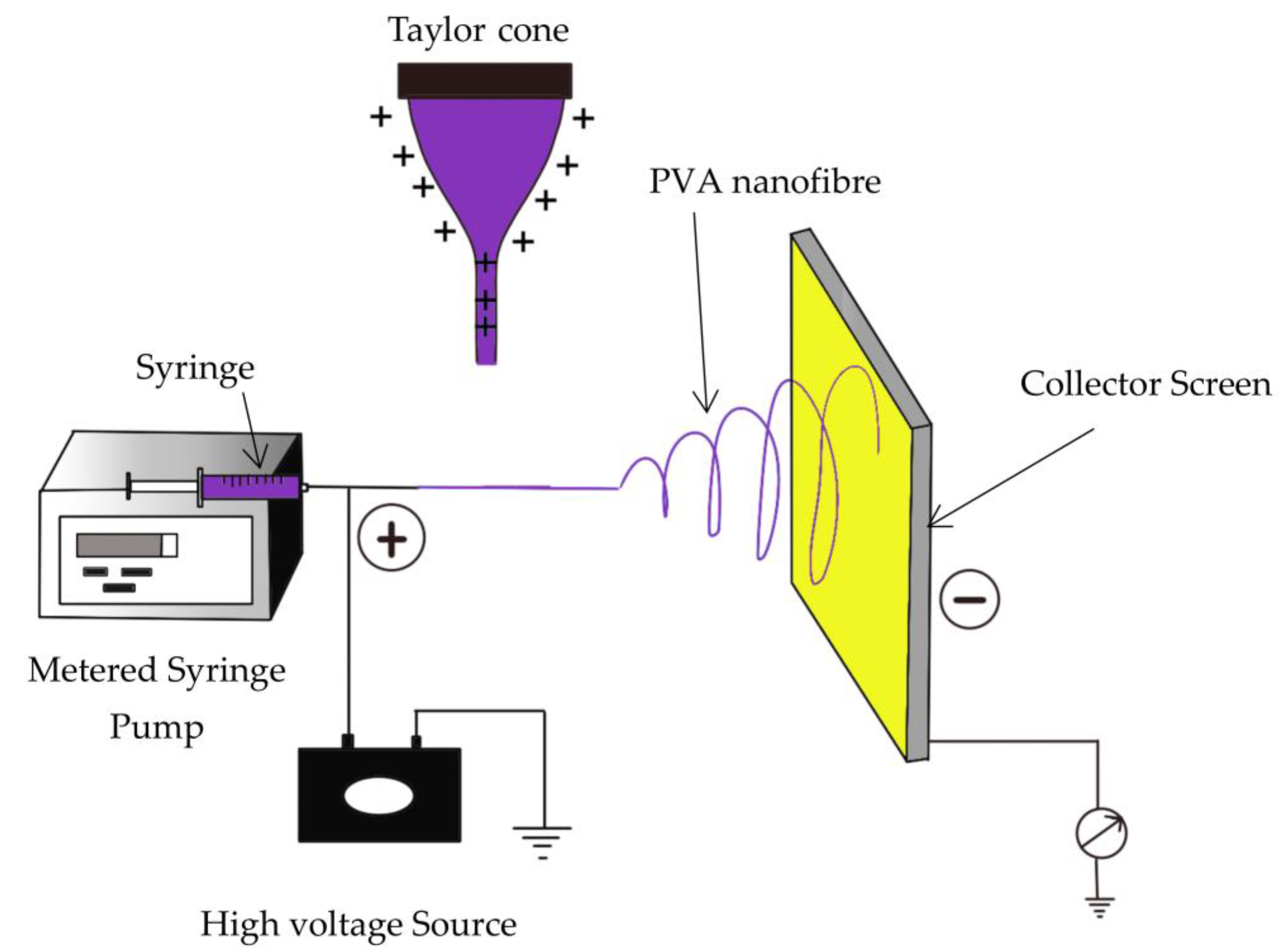
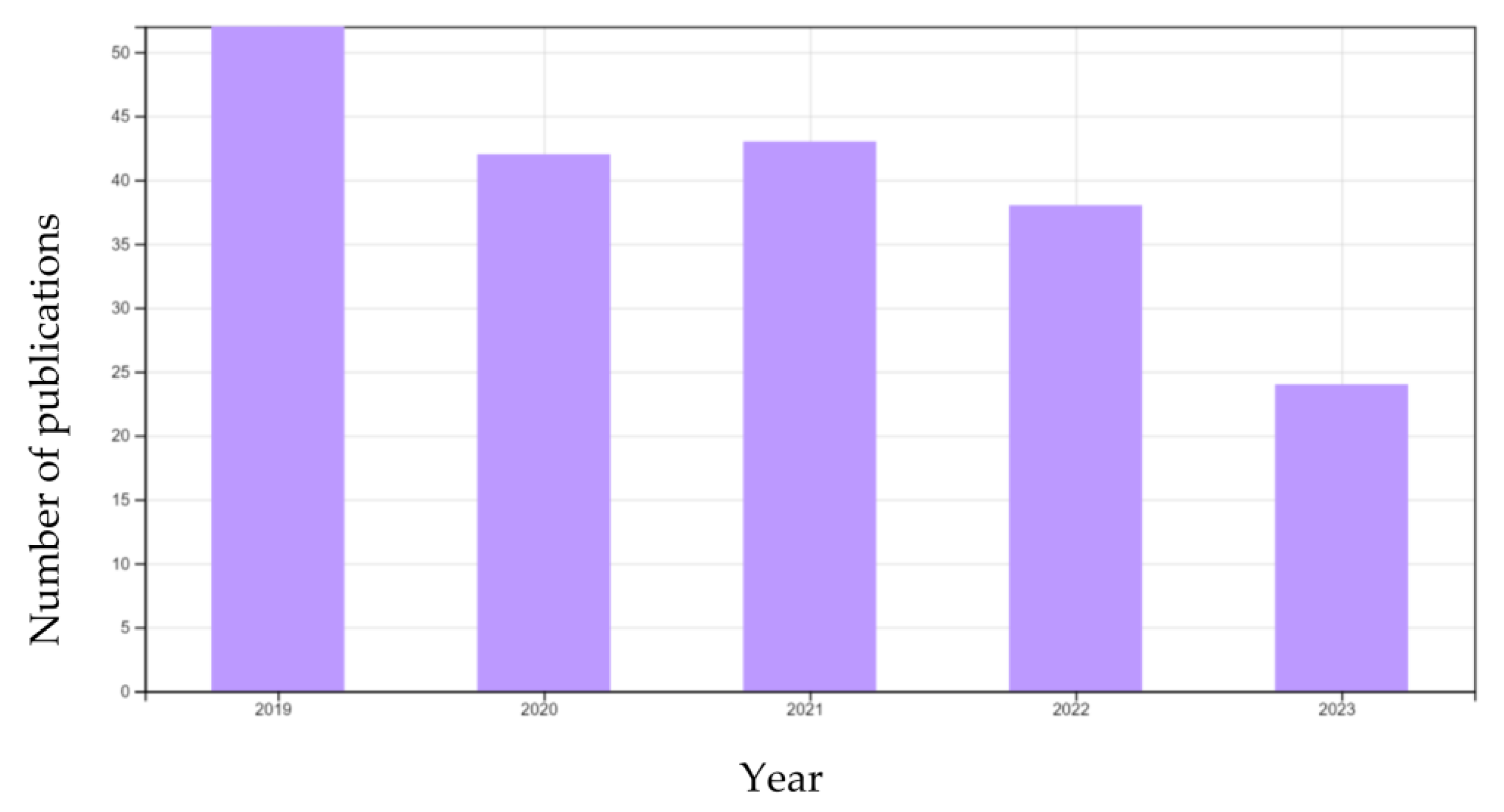

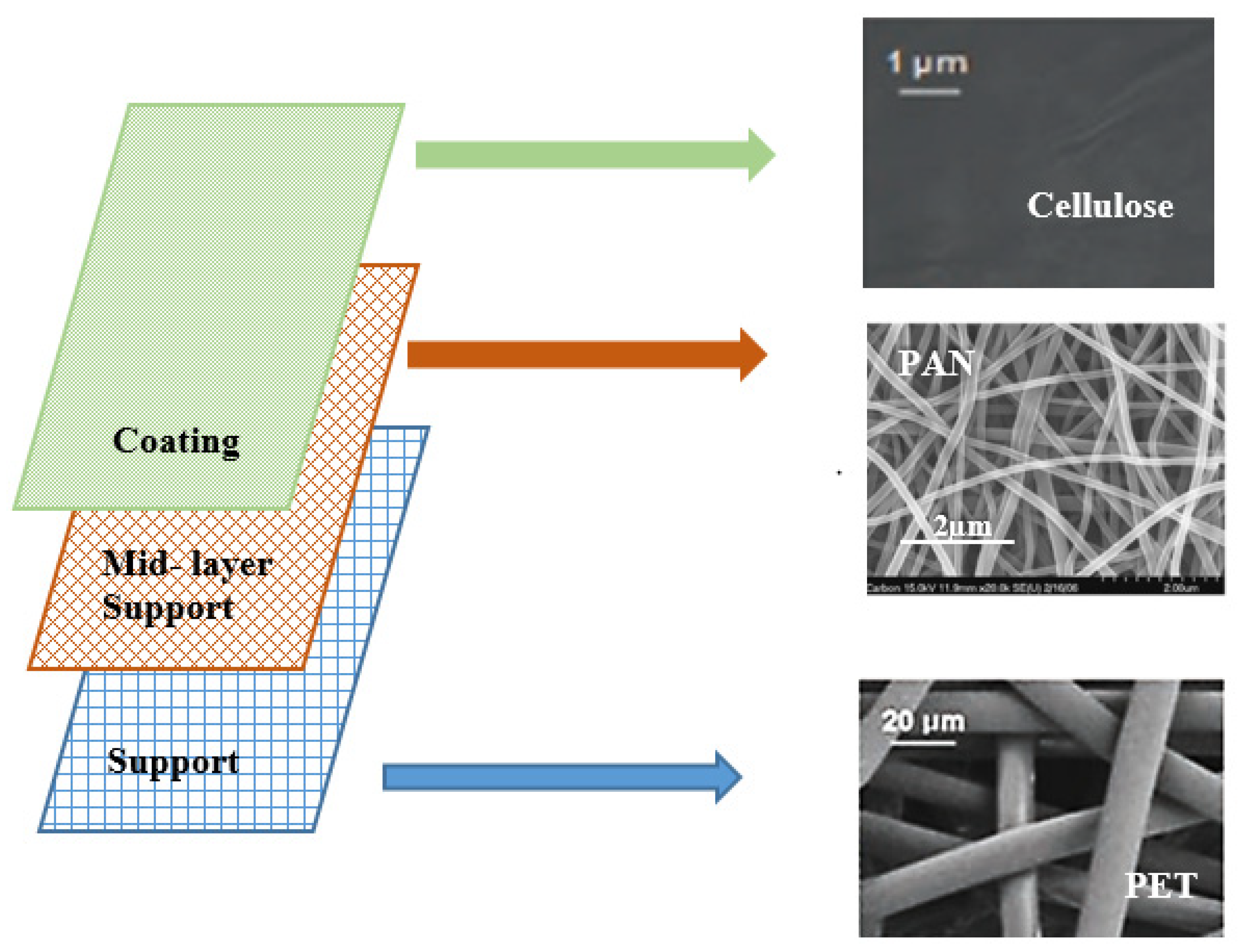

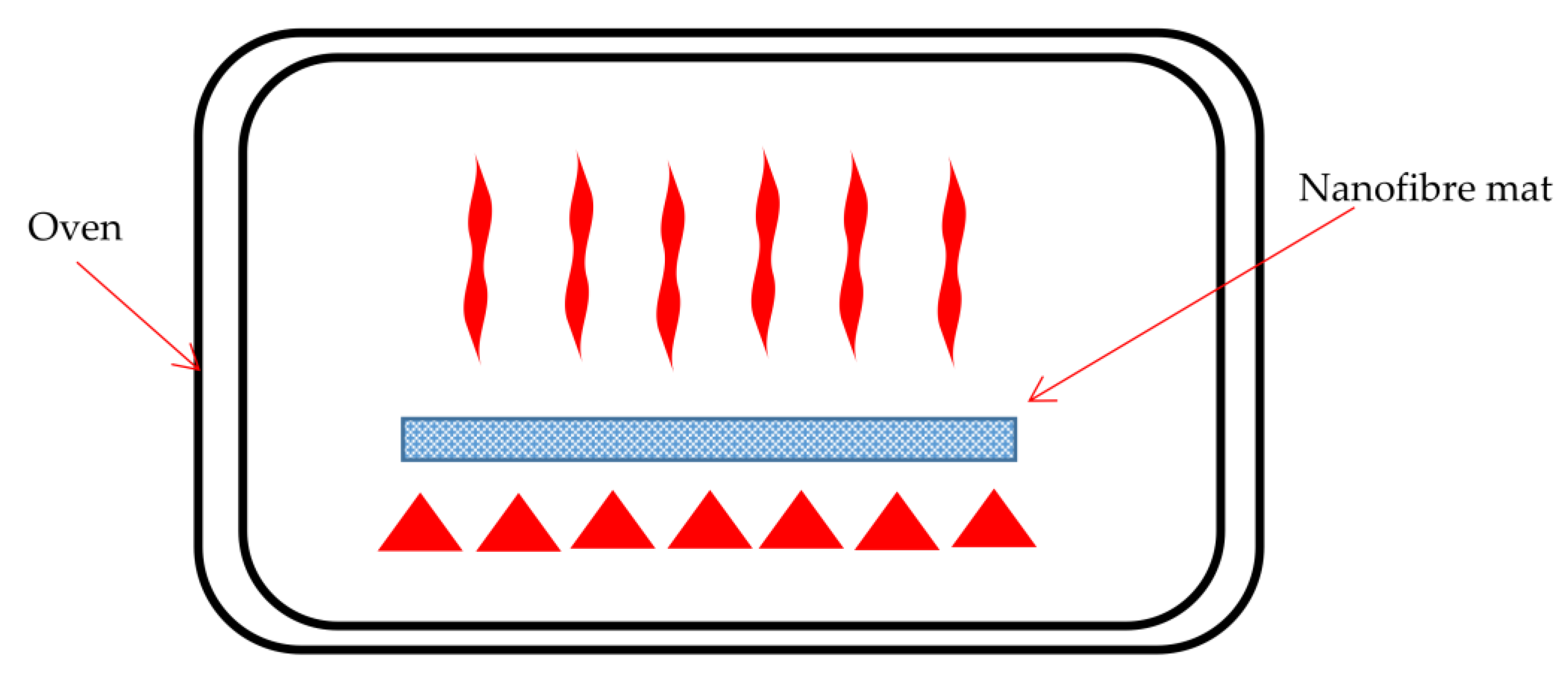

| Nanofibre Polymer | Treatment | Tensile Strength (MPa) | Young’s Modulus (MPa) | Ref. |
|---|---|---|---|---|
| Nylon 6,6 | Solvent Vapour | Untreated: 737 MPa Treated: 1407 MPa | NA | [22] |
| Polyacrylonitrile (PAN) and Polysulfone (PSu) | Solvent Vapour | Untreated PAN: 5.59 MPa Untreated PSu: 0.83 MPa Method A (Nanofibres were left on an aluminium foil): PAN: 23.84 Mpa Psu: 3.35 MPa | Untreated PAN: 57.31 MPa Untreated PSu: 11.7 MPa Method A (Nanofibres were left on an aluminium foil): PAN: 523 Mpa Psu: 44.62 MPa | [29] |
| Method B (Nanofibres were removed from the foil): PAN: 8.78 Mpa Psu: 1.47 MPa | Method B (Nanofibres were removed from the foil): PAN: 73.7 MPa Psu: 24.75 MPa | |||
| Polyphenylsulfone (PPSU) | Thermal treatment | Untreated: 0.43 MPa Treated: 4.10 MPa | [42] | |
| Polysulfone (PSU) & Polyacrylonitrile (PAN) | Thermal treatment | Untreated: 0.58 MPa Treated: 0.88 MPa | NA | [47] |
| Polyacrylonitrile (PAN) and polysulfone (PSu) | Chemical crosslinking | Untreated PAN: 5.27 MPa Treated PAN: 10.48 MPa | Untreated PAN: 73.1 MPa Treated PAN: 163.3 MPa | [21] |
| Untreated Psu: 1.02 MPa Treated PSu: 2.18 MPa | Untreated Psu: 12.2 MPa Treated PSu: 38.3 MPa | |||
| Bamboo cellulose (B-CA) | Chemical crosslinking | Untreated: 3.9 MPa Treated: 7.7 MPa | Untreated: 222.6 MPa Treated: 291.8 MPa | [41] |
| Silk-Fibroin/Poly(ethylene oxide) | EB irradiation | SF-PEO-10/N2: 142.17 | SF-PEO-10/N2: 131.61 | [56] |
| SF-PEO-25/N2: * 266.27% | SF-PEO-25/N2: * 58.26% |
Disclaimer/Publisher’s Note: The statements, opinions and data contained in all publications are solely those of the individual author(s) and contributor(s) and not of MDPI and/or the editor(s). MDPI and/or the editor(s) disclaim responsibility for any injury to people or property resulting from any ideas, methods, instructions or products referred to in the content. |
© 2023 by the authors. Licensee MDPI, Basel, Switzerland. This article is an open access article distributed under the terms and conditions of the Creative Commons Attribution (CC BY) license (https://creativecommons.org/licenses/by/4.0/).
Share and Cite
Hami, S.S.B.M.; Affandi, N.D.N.; Indrie, L.; Tripa, S.; Harun, A.M.; Ahmad, M.R. Enhancing Mechanical Properties and Flux of Nanofibre Membranes for Water Filtration. Polymers 2023, 15, 3281. https://doi.org/10.3390/polym15153281
Hami SSBM, Affandi NDN, Indrie L, Tripa S, Harun AM, Ahmad MR. Enhancing Mechanical Properties and Flux of Nanofibre Membranes for Water Filtration. Polymers. 2023; 15(15):3281. https://doi.org/10.3390/polym15153281
Chicago/Turabian StyleHami, Siddratul Sarah Binti Mohd, Nor Dalila Nor Affandi, Liliana Indrie, Simona Tripa, Ahmad Mukifza Harun, and Mohd Rozi Ahmad. 2023. "Enhancing Mechanical Properties and Flux of Nanofibre Membranes for Water Filtration" Polymers 15, no. 15: 3281. https://doi.org/10.3390/polym15153281
APA StyleHami, S. S. B. M., Affandi, N. D. N., Indrie, L., Tripa, S., Harun, A. M., & Ahmad, M. R. (2023). Enhancing Mechanical Properties and Flux of Nanofibre Membranes for Water Filtration. Polymers, 15(15), 3281. https://doi.org/10.3390/polym15153281






